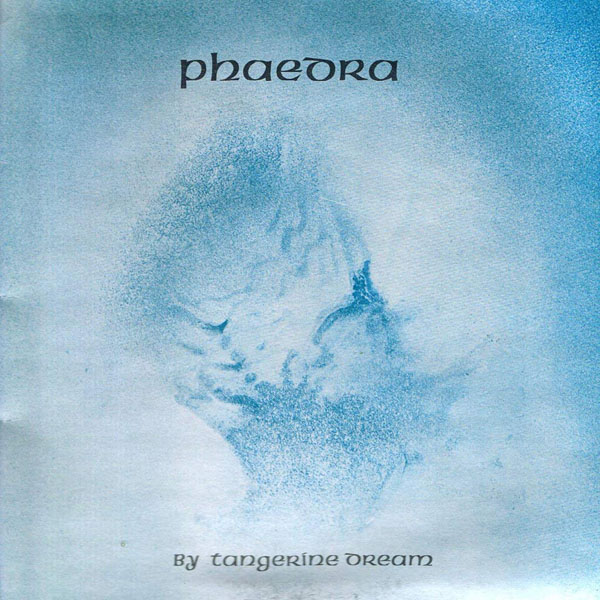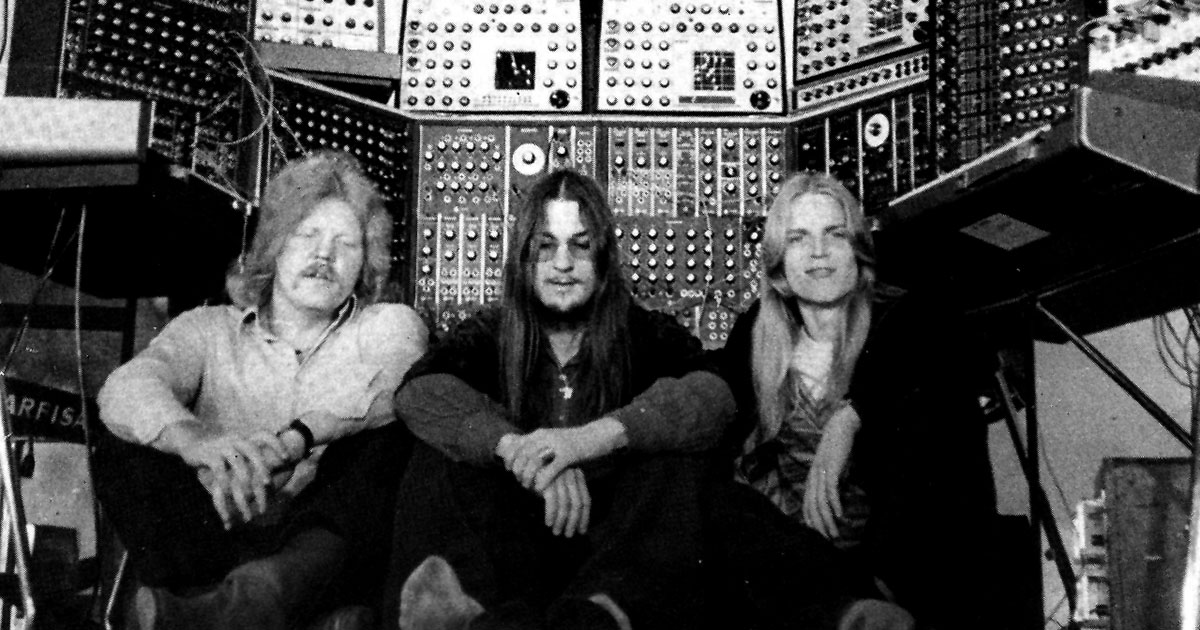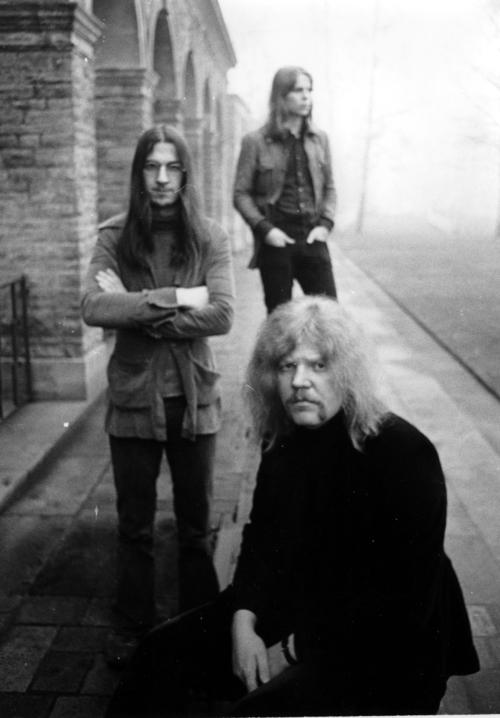An Electronic Meditation on Tangerine Dream's Phaedra at 50.
by John Diliberto 2/20/2024
 Hear our radio meditation on Tangerine Dream tonight, 2/20, or in the Echoes Podcast on Thursday.
Hear our radio meditation on Tangerine Dream tonight, 2/20, or in the Echoes Podcast on Thursday.
There would probably not be an Echoes radio program without the band and the album we’re celebrating on today’s broadcast of Echoes. That’s Tangerine Dream and their 1974 release, Phaedra. In 1973, Three German musicians: Edgar Froese, Christoph Franke and Peter Baumann, entered The Manor Studio in England and created a sound that I would argue was an entirely new kind of music.
Tangerine Dream was formed in the late 1960s during the psychedelic movement and released their debut, Electronic Meditations in 1970. Electric guitars, organs, violins, metal, whips, and cellos were distorted to the limits by founder Edgar Froese and Conrad Schnitzler, and set against Klaus Schulze’s free-form drumming. Schulze described it as being like a punk album. Things got even more interesting, and honestly, more listenable, on their next three recordings, Alpha Centauri, Zeit and Atem, which were marked by the gradual introduction of Mellotron and the VCS3 synthesizers. Their often free-form explorations made Pink Floyd sound like a rural blues band by comparison. Alpha Centauri bears a dedication to “all people who feel obliged to space.” They experimented with subtler textures, and on the double record Zeit, used a string quartet in the manner of Gyorgy Ligeti’s “Atmospheres.”
 With Zeit, the personnel stabilized around founder Edgar Froese, Christoph Franke, and Peter Baumann. They were a very underground band until they were signed to Virgin Records in England. They trekked to the label’s The Manor Studio where albums like Mike Oldfield’s Tubular Bells had been recorded bringing along some new gear, including a Moog Modular synthesizer and sequencers, which would become a trademark of their music.
With Zeit, the personnel stabilized around founder Edgar Froese, Christoph Franke, and Peter Baumann. They were a very underground band until they were signed to Virgin Records in England. They trekked to the label’s The Manor Studio where albums like Mike Oldfield’s Tubular Bells had been recorded bringing along some new gear, including a Moog Modular synthesizer and sequencers, which would become a trademark of their music.
I remember the first time I heard this album in 1974. I hadn’t yet understood the genius of Wendy Carlos, and Tonto’s Expanding Headband didn’t seem like a sound that forecast the future. I was into experimental electronic music like Charles Wuorinen’s Time’s Encomium and Morton Subotnick’s Silver Apples of the Moon, but Phaedra spoke in a different way. The textures were enveloping, the sequencer rhythms provided an anchor and a pathway through a new world of sound. It’s often called the Berlin School and there are scores of graduates from that imaginary institution, still churning out retro-space music. But that categorization is kind of reductive, since the Dream explored structures and improvisations well outside their signature sequencer sound. There were the mellotron-driven textures of “Mysterious Semblance at the Strand of Nightmares.” If you know Dream founder Edgar Froese, you know that’s one of his titles, and he mostly composed this track, which is centered on the Mellotron and a lot of filter sweeps and flanging, as he dropped-in layers of ghostly strings and effects.
Then there’s “Movements of a Visionary.” This a truer ensemble piece that emerges out of deep space silence with alien sounds and distorted voices, emerging like static that might excite a SETI researcher. Synth scribbles emerge and then the sequencer starts percolating in delayed symmetry. All the sounds begin coalescing around that sequence, including some Rick Wright-like organ swirls, electric piano, and some more organ as the trio improvises in space. The album concludes with a short vignette by Peter Baumann, “Sequent C,” layering long classical recorder tones into echoing space.

Tangerine Dream circa 1974
The centerpiece of the album is the entire first side, comprised of the title track. Clocking in at 17:39, it’s a space music epic in two parts. Like “Movements of a Visionary,” it begins in abstract space as electronic sounds act like shimmering cymbals, while others emit ringtones from beyond. Then the sequencers come in. For a long time, they are a slow, low gurgle as sound effects cascade over them. But at 5:05, with a surging crescendo roar, the sequencers fully erupt in a cosmic space twang. This is the sound that would characterize the Dream and reshape music for the future. Mellotron riffs float in and out, warped by effects, as the piece seems to be driving into infinity. Elastic sounds whip by, like fleeting images flashing past the windows of a speeding train. The piece builds to a climax and then suddenly pulls everything out, dropping you into empty space, where slowly, spring-like sounds emerge, and a mellotron enters with a cathedral dirge. Slowly, gently, it brings you back to earth, forever transformed.
There are several alternate takes available on the deluxe reissue of Phaedra, and those versions include acoustic piano, different sequences, and movements that make the evolution of this composition even more fascinating. Tangerine Dream had been operating at a highly experimental level, but this final experiment turned out to be a masterpiece. Just think: there are no vocals, no guitar solos, no drums. There is nothing that had usually constituted a music recording. It was an entirely new kind of music. Yet, it went up to number 15 on the British music char with its liquid textures and insistent rhythms that sounded like giant cosmic rubber bands.
The 1977 hit, “I Feel Love” by Donna Summer is completely beholden to Tangerine Dream’s Phaedra, even if everybody likes to cite Kraftwerk as the influence. And 42 years after Phaedra was released, the theme from Stranger Things, and much of that soundtrack, was completely indebted to Phaedra. Like The Velvet Underground and Nico, where everyone who heard it started a band, everyone who heard Phaedra plugged in, or, tripped out. 50 years later, Tangerine Dream’s Phaedra still sounds like the future; a future that is a cosmic and hallucinogenic ride.
Hear our radio meditation on Tangerine Dream tonight, 2/20, or in the Echoes Podcast on Thursday.
Hear our documentary on Tangerine Dream in the Echoes Podcast here..
Hear our complete 1982 interview with Edgar Froese here.
See our list of Ten Tangerine Dream Albums to Blow Your Mind.
Hear our interview with the current edition of Tangerine Dream here.

Great write-up – took me back to going and seeing, listening to, the guys at the Rainbow later in 1974. Huge thanks to John Peel for making a very young me aware of how music can impact from inside the head and body well beyond heavy bass lines.
Thanks